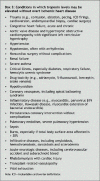Troponin: the biomarker of choice for the detection of cardiac injury
- PMID: 16275971
- PMCID: PMC1277047
- DOI: 10.1503/cmaj/051291
Troponin: the biomarker of choice for the detection of cardiac injury
Erratum in
- CMAJ. 2005 Dec 6;173(12):1490
- CMAJ. 2006 Jan 31;174(3):353
Abstract
It has been known for 50 years that transaminase activity increases in patients with acute myocardial infarction. With the development of creatine kinase (CK), biomarkers of cardiac injury began to take a major role in the diagnosis and management of patients with acute cardiovascular disease. In 2000 the European Society of Cardiology and the American College of Cardiology recognized the pivotal role of biomarkers and made elevations in their levels the "cornerstone" of diagnosis of acute myocardial infarction. At that time, they also acknowledged that cardiac troponin I and T had supplanted CK-MB as the analytes of choice for diagnosis. In this review, we discuss the science underlying the use of troponin biomarkers, how to interpret troponin values properly and how to apply these measurements to patients who present with possible cardiovascular disease.
Figures






References
-
- Takeda S, Yamashita A, Maeda K, et al. Structure of the core domain of human cardiac troponin in the Ca(2+)-saturated form. Nature 2003;424:35-41. - PubMed
-
- Dhoot GK, Gell PG, Perry SV. The localization of the different forms of troponin I in skeletal and cardiac muscle cells. Exp Cell Res 1978;117:357-70. - PubMed
-
- Dhoot GK, Perry SV. Distribution of polymorphic forms of troponin components and tropomyosin in skeletal muscle. Nature 1979;278:714-8. - PubMed
-
- Schreier T, Kedes L, Gahlmann R. Cloning, structural analysis, and expression of the human slow twitch skeletal muscle/cardiac troponin C gene. J Biol Chem 1990;265:21247-53. - PubMed
Publication types
MeSH terms
Substances
LinkOut - more resources
Full Text Sources
Other Literature Sources
Research Materials
Miscellaneous
